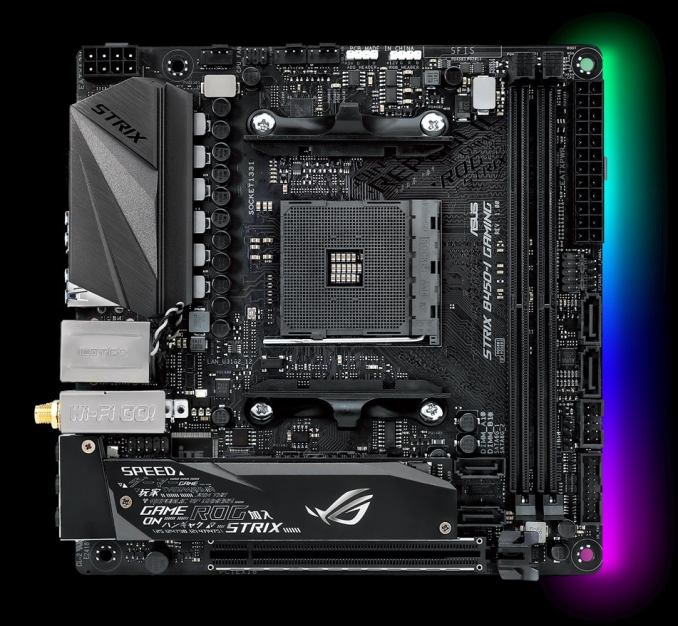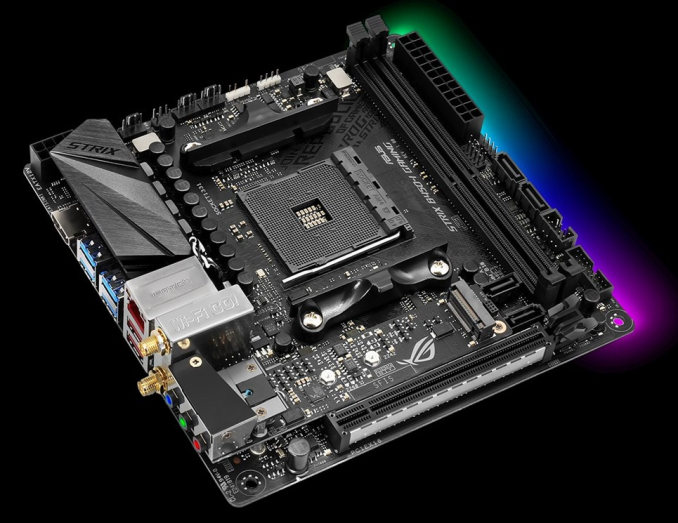Analyzing B450 for AMD Ryzen: A Quick Look at 25+ Motherboards
by Gavin Bonshor on July 31, 2018 8:00 AM ESTASUS ROG Strix B450-I Gaming
While the B450-I is the smaller sibling of the Strix B450-F, it packs a mighty punch in feature sets with a host of good quality components usually found on mITX form factor boards over the years from ASUS. The Strix B450-I includes a ROG SupremeFX S1220A audio codec with dual operational amplifiers, an Intel I211-AT Gigabit LAN controller and an Intel 802.11ac Wi-Fi adapter with MIMO capabilities built-in.
Looking closer at the Strix B450-I, the general theme follows that of the Strix B450-F board. The Strix B450-I follows a more subtle and clandestine style primarily due to its size, with a metallic grey heatsink which sits above the rear panel and MOSFETs. The RGB lighting built-in spans across the right-hand side of the board offers a unique and customizable under glow thanks to the ASUS Aura Sync technology which means it can be synchronized up with compatible peripherals and components such as graphics cards. On top of this are a single addressable RGB header and a regular RGB header.
Due to the size limitations on smaller form factor motherboards such as this one, there is only a single full-length PCIe 3.0 x16 slot which is covered in ASUS’s SafeSlot metallic armor coating to protect against slot damage from the heavier load bearing graphics cards.
Focusing on memory support, the smaller form factor has its benefits in this department as the ROG Strix B450-I supports up to DDR4-3600 with a maximum capacity of up to 32 GB of system memory split across two memory slots. Smaller form factor boards from ASUS generally tend to perform well in the memory stakes due to the closer tracks between the CPU socket and the RAM slots themselves, usually giving the memory lower latencies; although the benefits are marginal at best in real-world scenarios, they make quite a difference in situations such as benchmarking and sub-zero overclocking.
Touching more on the power capabilities, the Strix B450-I seems to feature an 8 phase Digi+ power delivery in a 6+2 configuration, with an 8-pin ATX 12 V power input to power the processor. In addition to this is a standard 24-pin ATX power connector featured on the right-hand side of the board.
The ASUS ROG Strix B450-I has a combined total of three 4-pin connectors spread across a dedicated header for a CPU fan, a single chassis fan connector and a specific connector for an AIO CPU cooler pump, or water cooling pump. Like most B450 motherboards, this particular model has a simple clear CMOS jumper instead of a button and has the capability to increase the number of USB ports through internal headers by a further two USB 3.1 5 Gbps and two USB 2.0 ports.
Making up the storage options on the Strix B450-I are four SATA 6 Gbps ports with all four of them being angled straight out of the board; we find two each on either side of the memory slots. The SATA 6 Gbps ports offer support for RAID 0, 1 and 10 arrays. In addition to the available SATA ports is a duo of M.2 slots with both slots accommodating drives up to M.2 2280 (22 x 80 mm), and both supporting the PCIe 3.0 x4 interface. One of the slots is located just above the full-length PCIe 3.0 x16 slot and features an integrated M.2 heatsink which has the futuristic text. The second slot is located on the rear of the PCB and features no cooling options other than available passive cooling from the system its installed into.
The audio is the same ROG SupremeFX S1220A audio codec found on the B450-F but is also supplemented by a pairing of operational amplifiers to further enhance the sound. Due to the size limitations, the SupremeFX S1220A codec only allows a total of three 3.5mm audio jacks on the rear panel, but they do contain an element of LED illuminated goodness; if that’s considered a selling point for an ITX board. In addition to the audio capabilities, the rear panel also has a total of four USB 3.1 5 Gbps Type-A ports and a pairing of USB 3.1 10 Gbps Type-A ports which are distinguished by their red color.
Finishing off the connections on the ROG Strix B450-I is an Intel I211-AT controlled Gigabit LAN port, two slots to attach the two included antennas to capitalize on the built-in 802.11ac MIMO 2T2R capable Wi-Fi module with Bluetooth 4.2 support, and last but most certainly not least, a single HDMI 2.0b capable video output for use with the Ryzen APUs.
It’s clear that the ROG Strix B450-I is a formidable offering featuring the same 8-phase Digi+ power delivery with two more than most ASUS B450 boards at launch, as well as a svelte integrated M.2 heatsink offering some function to users looking to utilize an NVMe capable drive in a small form factored PC, as well as some points in the style stakes too. The B450-I would be more suited to a powerful gamer with a beefy pixel rendering goliath such as an NVIDIA GTX 1080 Ti paired off with a Ryzen 2700X processor and DDR4-3600 memory for a pocket rocket gaming system. The expected retail price is currently unknown as of yet.





_thumb.jpg)
_thumb.jpg)
_thumb.jpg)
_thumb.jpg)
_thumb.jpg)
_thumb.jpg)








62 Comments
View All Comments
tonecas1 - Tuesday, October 30, 2018 - link
Asus Prime 450M-K has only 4 Sata ports, audio is Realtek’s ALC887 only, and memory support goes to 3466 (OC)tonecas1 - Tuesday, October 30, 2018 - link
Asus Prime 450M-K has 2 PCIe 2.0x1 and 1 PCIe 3.0 x16 by CPU supporttonecas1 - Tuesday, October 30, 2018 - link
MSI B450M Pro-M2 only supports 2x DIMM slotstonecas1 - Wednesday, October 31, 2018 - link
ASRock B450M Pro4 is not a 6+3 power system but a 3+3. You have to remove the heat sink to see the MOSFET Hi and Lo combos and IC controlersQuarterPunder - Tuesday, March 5, 2019 - link
So if i buy this motherboard do i still need to buy a wifi card/Bluetooth receptor???msroadkill612 - Wednesday, March 20, 2019 - link
"Strix B450-F Gaming ..... Also present is a duo of M.2 slots with both having support for PCIe 3.0 x4 M.2 drives, while the top slot which supports both PCIe and SATA drives up to a size of M.2 2280 (22 x 80 mm), the bottom slot only supports PCIe 3.0 x4 drives with a sizing up to M.2 22110 (22 x 110 mm)."ALARMINGLY WRONG!
Newegg:
"AMD Ryzen 2nd Generation / Ryzen 1st Generation Processors: *
1 x M.2 Socket 3, with M key, type 2242/2260/2280 storage devices support (SATA & PCIE 3.0 x4 mode)**
1 x M.2 Socket 3, with M key, type 2242/2260/2280/22110 storage devices support (PCIE 3.0 x4 mode)***"
msroadkill612 - Wednesday, March 20, 2019 - link
edit - to remove any doubt - in full, the specs are:"AMD Ryzen 2nd Generation / Ryzen 1st Generation Processors: *
1 x M.2 Socket 3, with M key, type 2242/2260/2280 storage devices support (SATA & PCIE 3.0 x4 mode)**
1 x M.2 Socket 3, with M key, type 2242/2260/2280/22110 storage devices support (PCIE 3.0 x4 mode)***
AMD Ryzen with Radeon Vega Graphics Processor: *
1 x M.2 Socket 3, with M key, type 2242/2260/2280 storage devices support (SATA & PCIE 3.0 x4 mode)**
* Support StoreMI and NVMe RAID.
** When the M.2_1 Socket 3 is operating in SATA or PCIE mode, SATA6G_5/6 ports will be disabled.
*** When the M.2_2 is occupied by M.2 device, PCIe x16_1 will run at x8 mode."
g0rnex - Sunday, June 23, 2019 - link
I run windows from external SSD so I need fast USB ports for it to run smooth. Can I replace the USB ports by 3.2 gen2 when needed?g0rnex - Sunday, June 23, 2019 - link
I run win10 from an external SSD. for that I need a fast USB connection for windows to run smooth.Would it be possible to change the USB ports in the future? OR even now already by a 3.2 gen2. Or wouldn't replacing the ports speed up my connection with the external SSD?
Also I would like a good bluetooth connection. Do I need to use an adapter?
looking into making this build:
https://pcpartpicker.com/guide/hXzKHx/entry-level-...
GayCock69 - Monday, August 19, 2019 - link
ryzen 3700x + aorus pro wifi b450 + radeon rx5700xt, will it work optimally?